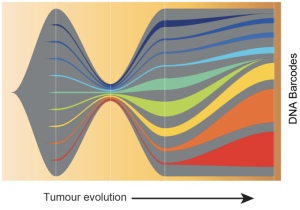Life Sciences
Cancer Cells’ Ability to Escape Immunity is Pre-Existing, DNA Barcoding Study Says
Researchers used a DNA barcoding method to analyze immunoediting—the process of cancer cells evading the immune system—in vivo. Looking in both primary…

Immunoediting (the process by which cancer cells evade the immune system) results when cancer cells that are more immunogenic are selectively eliminated, resulting in a population of less-immunogenic cancer cells that are able to expand. In a new study, researchers used a DNA barcoding method to analyze immunoediting in vivo. Looking at both primary tumors and metastases, the researchers asked whether resistance to immune checkpoint inhibition develops from pre-existing or de novo-generated cell populations.
The findings show that some cancer cells can deploy parallel mechanisms to evade the immune system’s defenses as well as resist immunotherapy treatment. Pre-existing cell populations are selected for at the primary site, metastases, and in the context of immunotherapy. By isolating immunotherapy-resistant clones, the team found that multiple mechanisms of immune evasion are maintained simultaneously in tumors. In addition, transcriptomic analysis revealed a common gene signature associated with poor survival in two cohorts of basal-like breast cancer.
This work is published in Nature Communications in the paper, “DNA barcoding reveals ongoing immunoediting of clonal cancer populations during metastatic progression and immunotherapy response.”
“We know that breast cancer typically doesn’t respond well to immunotherapy, and we wondered if there’s an intrinsic mechanism enabling breast cancer cells to escape the immune system,” said Louise Baldwin, a PhD student in the Swarbrick lab at the Garvan Institute in Australia.

The DNA barcoding method allowed the researchers to track the progression of tumor cells through time.
“We showed that there are rare cancer cells capable of escaping the immune system and escaping treatment with immunotherapy,” said Baldwin.
The researchers used barcoding to track mouse breast cancer cells during immunoediting and determine clonal transcriptional profiles that allow immune evasion following anti-PD1 plus anti-CTLA4 immunotherapy.
Clonal diversity, the authors noted, is significantly restricted by immunotherapy treatment in both primary tumors and metastases, “demonstrating selection for pre-existing breast cancer cell populations and ongoing immunoediting during metastasis and treatment.” Immunotherapy-resistant clones, they found, express a common gene signature associated with poor survival of basal-like breast cancer patient cohorts
Simon Junankar, PhD, a visiting scientist in the Swarbrick lab, wanted to understand “whether resistance was adaptive—whether cancer cells duck and weave—or are they pre-programmed to evade the immune system,” said Alex Swarbrick, PhD, associate professor at the Garvan Institute.
The team found that even before treatment, the cancer cells had diversified. “Some cells had already acquired the ability to evade immunity, meaning they have an innate ability to escape the immune system,” Swarbrick said.
The cells seem to do this with parallel approaches. One way is to suppress the action of killer T-cells, which would usually destroy harmful cells. The other is to reduce the expression of MHC I on cells, which act as a flag for the immune system to recognize harmful cells.
“Most tumor cells vanish when the immune system gets switched on, but a small proportion keep growing and expanding,” said Swarbrick. “Tumors keep evolving and diversifying, and action by the immune system or treatment like chemotherapy is like pruning a tree—cancer cells get wiped out but the remaining branches on the tree continue to grow.”
The post Cancer Cells’ Ability to Escape Immunity is Pre-Existing, DNA Barcoding Study Says appeared first on GEN – Genetic Engineering and Biotechnology News.

Wittiest stocks:: Avalo Therapeutics Inc (NASDAQ:AVTX 0.00%), Nokia Corp ADR (NYSE:NOK 0.90%)
There are two main reasons why moving averages are useful in forex trading: moving averages help traders define trend recognize changes in trend. Now well…
Spellbinding stocks: LumiraDx Limited (NASDAQ:LMDX 4.62%), Transocean Ltd (NYSE:RIG -2.67%)
There are two main reasons why moving averages are useful in forex trading: moving averages help traders define trend recognize changes in trend. Now well…
Asian Fund for Cancer Research announces Degron Therapeutics as the 2023 BRACE Award Venture Competition Winner
The Asian Fund for Cancer Research (AFCR) is pleased to announce that Degron Therapeutics was selected as the winner of the 2023 BRACE Award Venture Competition….














